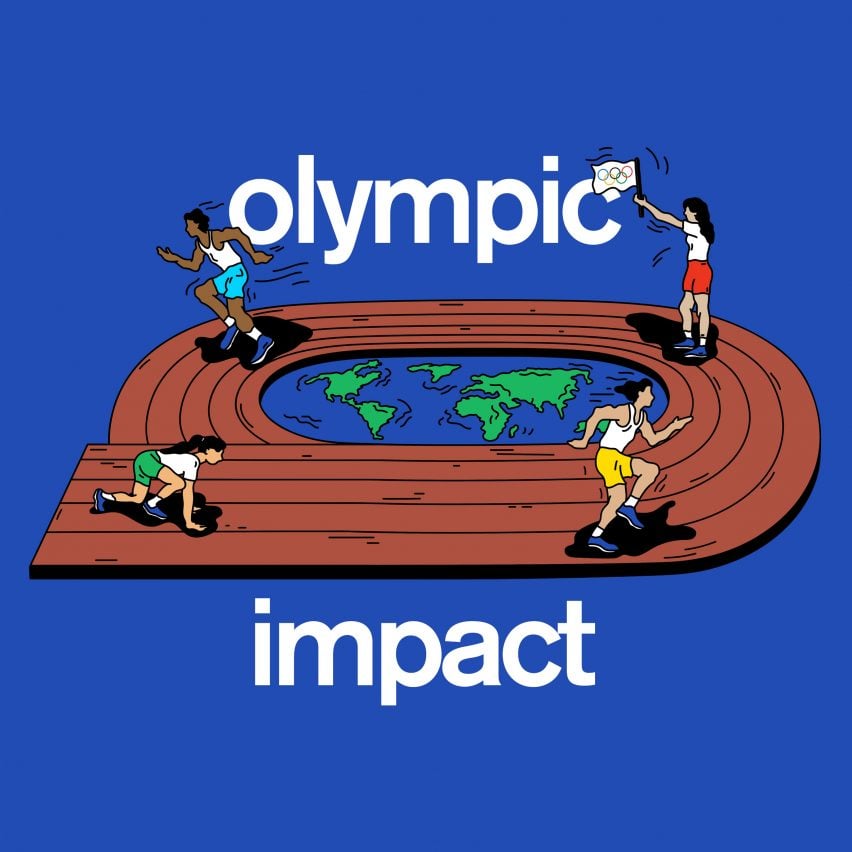The Olympic Games cannot continue in their current form, sustainability experts have told Dezeen as part of our Olympic Impact series.
“The current format – where you have an overwhelming spectacle that takes over a city, like an extravagance, a postmodern spectacle – I don’t think that can continue,” said Sven Daniel Wolfe, lecturer at the Department of Civil, Environmental and Geomatic Engineering at ETH Zurich.
“Unfortunately, even though it’s a huge amount of fun, and it is magic, it is also destructive.”
“In order to stop that from happening, both in terms of carbon output but also just in terms of social impacts, we have to have some sort of a systemic change for the good of the games and the cities and societies that host them.”
“We shouldn’t have the Olympics,” added Seth Rose, director of sustainable development advocacy organisation Eneref Institute.
“It’s heartbreaking to think that there are some events we can’t do anymore, but bringing people to an event is very energy-intensive and we need to rethink how we live as a society because if we don’t, Mother Earth is going to force our hand.”
Progress on construction offset by international travel
The 33rd Olympic Games are currently underway in Paris, with the French capital setting out to reduce the carbon impact of the event significantly compared to previous games.
Paris 2024 is the first Olympics organised to a carbon budget, with an ambition to emit no more than 1.58 million metric tonnes of CO2 equivalent – half the carbon footprint of London 2012 and Rio 2016.
To achieve that goal, organisers have mostly focused on minimising construction, with 95 per cent of the competition venues being pre-existing or temporary structures.
Wolfe commended the achievements that have been made at the games in this regard.
“We’re facing a situation where we cannot continue to build a number of oversized and unnecessary infrastructures, so it’s great to see something like Paris happen, where they’re using stadiums that are already built,” he said.
“That’s the kind of progress that mega-event scholars like myself and my colleagues have been calling for for a number of years.”
But he argued it is not enough to counteract the fundamentally unsustainable nature of major global sporting events, where a large number of athletes and spectators travel from around the world into one host city.
“What we’re seeing is the gains from all of those existing infrastructures being counterbalanced by the extreme carbon output taken by very, very large games,” said Wolfe.
There is consensus among experts that the biggest sustainability challenge for major sporting events like the Olympics is the amount of international travel they attract.
Around 1.5 million foreign spectators are expected to descend on Paris this summer for the Olympics and Paralympics, with most journeying by air.
“The main problem with the way events are organised today is there is a high concentration of international fans in one specific city or a country, and this is the major contributor to the carbon footprint of any big sporting event, including the Olympic Games,” said University of Lausanne senior researcher David Gogishvili.
“Unfortunately, the International Olympic Committee (IOC) and local organisers have decided this would not be the main target where carbon footprint will be reduced,” he continued. “The biggest focus has been on the reduction of the construction of new venues.”
IOC opposed to multi-host model
Like many of his peers, Gogishvili argues that future games should be held across multiple host cities and countries, with locations selected based on existing infrastructure and local interest in certain sports.
“The IOC could choose five or six locations in different countries globally, choosing host sites that make sense in terms of the popularity of certain sports disciplines and the existence of already built infrastructure,” he said.
“In this case, the fan travel would be limited regionally and to locations with sustainable transport connections.”
“I can imagine this type of event would be more complex to organise in terms of management and operations, but the potential positive outcomes are significant.”
In an interview with Dezeen, IOC corporate and sustainable development director Marie Sallois said that while the committee has considered the arguments for spreading each Olympics across multiple locations, it currently has no plans to do so.
Spreading events across the world seems like a good idea, but it completely undermines this idea of bringing people together through the inspirational power of sport,” she said, while also questioning whether doing so would ultimately reduce emissions as some spectators may travel for multiple events.
Instead she indicated that the IOC’s strategy will be to reduce the footprint of the games in their current format where possible and wait for the aviation industry to decarbonise.
Like Sallois, Arup sustainability services leader Natasha Connolly has some reservations about multi-host city events.
She suggested the 2026 FIFA World Cup, set to take place in 16 cities across Canada, the US and Mexico, will provide further insight on the travel behaviour of spectators at major sporting events spread across geographies.
“It will be interesting to see whether it means fans travel more because they’ve got to travel from city to city and country to country to watch their team, or whether the scheduling will focus the events in one place,” she said.
“They can’t really be mega anymore”
There is another potential way to limit polluting international travel to future Olympics: reduce the size of the event altogether.
“If you really want to have something like a net-zero mega-event, my contention would be that they can’t really be mega anymore,” said Wolfe.
“That looks like shrinking or dispersing the games or having some kind of alternative format that involves more people online.”
“Some way of organisation that discourages fan travel from afar would be really important, even though that takes away some of the magic of the mixing of people and the giant party atmosphere,” he added. “I don’t see how we can have our cake and eat it too.”
Rose shares Wolfe’s view. We have technology now that eliminates the need for getting all these people together,” he said.
“Most people watch sports events on television,” he continued. “Maybe we create movie theatres that show the Olympics and people go and pay for it that way – there’s an advantage to that because you’re seeing it with your community.”
Arup host cities business leader Nick Merridew predicted that these kinds of setups may increasingly become a reality.
“We are still going to have spectators because spectators make the event, but I do foresee a trend where venues are getting smaller and people are viewing it in fanfests, rather than in the event themselves,” he said.
However, he suggested that the focus on people travelling to the Olympics may be misplaced – arguing that many would-be international spectators would likely spend their time and money on different forms of travel and tourism if they weren’t able to attend the games.
“What’s the difference between tourism and people going to a major event?” he asked. “International air travel is not going to go away.”
Attention will next turn to Los Angeles, which will host the next Summer Olympics in 2028.
Like Paris, LA plans to use mostly existing infrastructure – though the IOC has not yet set a clear sustainability plan or carbon emissions target.
“Organisers in LA have not yet hitched themselves onto the sustainability buzzword,” said Wolfe. “They will, as long as it’s still marketable by the time the games come around.”
The photo is by Alexandre Aymard via Unsplash.

Olympic Impact
This article is part of Dezeen’s Olympic Impact series examining the sustainability measures taken by the Paris 2024 Olympic and Paralympic Games and exploring whether major sporting events compatible with the climate challenge are possible.

